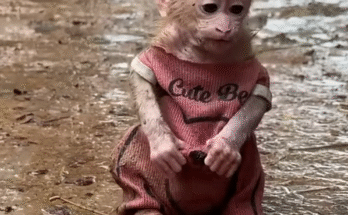
In the bright, unyielding sunlight, a tiny, sick puppy lay discarded in a ditch, left by his owner without a second thought. The ditch was shallow, offering little refuge from the scorching sun, and the puppy lay there, his body frail and vulnerable. This tragic scene was a powerful reminder of the cruelty and neglect that so many innocent animals endure. The puppy’s story is one of heartbreaking betrayal, a story that brings sorrow and anger to anyone who hears it.
This puppy, with soft, innocent eyes and a trusting heart, never expected his life to end in such a lonely place. He had once looked up at his owner with the same adoration that all dogs give, never questioning the intentions of the one he depended on. Yet, like an unwanted item, he had been cast aside in the cruelest way imaginable. It’s haunting to think of how he must have felt in that dark and lonely place, struggling through the night, hoping for comfort that never came.

But, as fate would have it, the puppy’s suffering did not go entirely unnoticed. A kind-hearted passerby happened to see the small creature lying helplessly in the ditch. Despite the heat, the dirt, and the discomfort, this compassionate stranger was moved by the sight of the abandoned puppy. Without a second thought, he climbed down into the ditch, willing to risk his own safety for a chance to save the little life before him. The scene was one of pure empathy, a stark contrast to the callousness that had led to the puppy’s abandonment.
Unfortunately, despite the rescuer’s best efforts, the puppy’s condition was too severe to be reversed. Years of neglect and the added shock of abandonment had taken their toll, and the puppy’s small body couldn’t endure any more suffering. The kind man held the puppy close, refusing to let him pass alone. Though the puppy’s life was brief and filled with hardship, in his final moments, he knew the touch of kindness, a warm presence by his side, and a heart that mourned his pain.

After the puppy passed, the man felt compelled to honor the little life he had tried so desperately to save. He found a peaceful, shaded spot and prepared a simple, respectful burial. It wasn’t just a goodbye to a dog he had only just met; it was a farewell to an innocent creature whose life had ended too soon and a tribute to the love and compassion that the rescuer carried in his heart. A small funeral was held, with the man standing as the puppy’s only witness, marking the spot with care and respect.
This puppy’s story reminds us of the countless animals who suffer in silence, victims of human indifference. Yet, it also highlights the enduring power of compassion, even when it comes too late. In a world that can sometimes seem cold and unforgiving, kindness remains a powerful force, a reminder that even in the darkest situations, empathy and love can bring a little light. The memory of the puppy’s final moments, embraced by kindness, serves as a call to protect and cherish all living beings, no matter how small or vulnerable.




